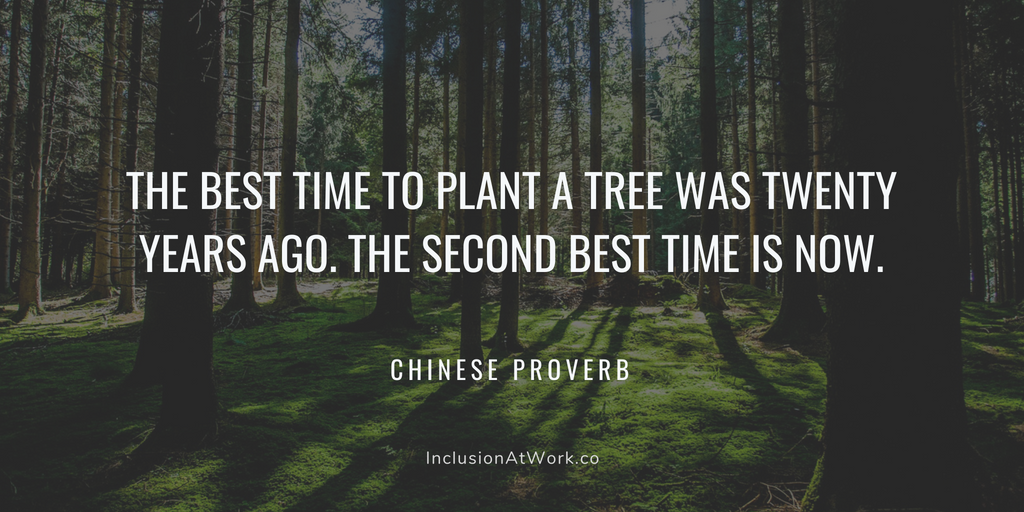The hardest part is starting
"None of us have experience in Diversity & Inclusion, and to be frank, it’s all a little overwhelming."

Submit your own question about Diversity & Inclusion here and subscribe to weekly posts here!
∗ ∗ ∗
Dear Inclusion At Work,
My team of 20 is starting to talk about what it means to have a diversity program. None of us have experience in this area, and to be frank, it’s all a little overwhelming. What are some starting points we should consider? Or, what do you wish you had known when you first started?
–Overwhelmed Founder
Dear Overwhelmed Founder,
I was recently at a conference where Patty McCord was speaking. She’s the legendary first Chief Talent Officer at Netflix, where she led a ton of innovative People Ops initiatives. She was asked by the audience which one she wishes she implemented earlier. Her answer’s stayed with me since: "I wish I did them all sooner. I just didn't have the courage."
We don’t usually think of D&I as emotionally brave work. But that’s exactly what it is — going into uncharted territory to do something important.
Few of us have been “formally” trained or educated on how to create better workplaces. Yet if you’re a leader of any kind, you gotta learn. This goes double for startup founders and builders of new teams. Because this work will be baked into your culture from day one, and the team members that you bring in from here on out will be invested with you.
That was the very much the case at my last startup, where I co-founded and led the D&I Taskforce when the company was just 10 employees. It was the fact that we started so early that resulted in real progress – Lever became known for 50/50 gender balance at 100 employees, as well as significant representation of Black/Latinx, LGBTQ, parents/caregiver employees, etc. And as I was leading the Taskforce and building up momentum around D&I, I wasn't spend more than 5-10% of my time on it for nearly 4 years. But a lot of little actions can compound to a lot over time.
Your results will be different than my last startup. But the point is, you have to start. It might help to remember that small teams are not expected to build flashy, labor-intensive D&I programs. Just like assembling your first sales team or figuring out marketing, it’s something you start learning by doing. Instead of seeing it as an intimidating “Do or Die” effort, see it as an organizational muscle you can develop – and the program will grow as the company does.
A few more thoughts:
-
There’s no one-size-fits-all. When it comes to D&I, challenges and solutions vary with every company. Just because X program worked for Google or Y was popular at Facebook, it doesn’t mean your small team would have the same results. Plus, most companies are very careful about what they share publicly, and we can only see the tip a very carefully curated iceberg – so finding “best practices” is tricky. Blindly copying corporate D&I programs probably won’t work. I always recommend startups start by looking inwards and considering the needs of the team, as well as being inspired by the external.
-
Effective D&I takes a holistic approach. For example, it’s very common for startups to hire a consultant for a Unconscious Bias training as a first step. Once that’s done, there’s often a moment of “now what?” and loss of momentum. The Kapor Center’s Tech Leavers Study (highly recommend the read) has found that one-off diversity initiatives are unlikely to be effective. Instead of seeing it as a one-and-done program, aim to build a program that’s sustainable, in keeping the conversation going through a variety of initiatives, big and small.
-
Effective D&I is also intersectional. This is a common trap that too many teams fall into. You want to be sure that your diversity programs don’t just focus on the low-hanging fruit (e.g. gender). Shying away from other aspects of diversity can inadvertently contribute to further inequity. Intersectionality is an area I also had to educate myself on, so here’s a whole post on it: “Intersectionality 101: Why “we’re focusing on women” doesn’t work for Diversity & Inclusion.”
-
Build upon your strengths! We could sit around pointing out all the things that could be done, but to get into action, we have to prioritize. So, consider your job as amplifying what’s working, rather than fixing everything that’s broken with D&I. What makes for a strong culture at your team? How did existing underrepresented employees find you and why did they join? Why are people proud of your company and how to do they describe it to others? Delve into these questions further to “mine” for insights, and they’ll be the guiding light for moving your D&I program forward.
(You might also find useful: “How to design original, impactful D&I programming”)
Overall, the main thing to remember is my first point – just start. And since D&I is no single individual’s responsibility, don’t go at it alone – start by forming an internal D&I taskforce or council. I’ll write more about it in future posts.
As anything that’s complex and important, the first step is the hardest. But I promise that D&I programs rooted in authenticity and sustainability will make your company so much better in the long run. To make it into a reality, you have to be brave.
Yours,
Jen

Looking for inspiration on where to start? Check out my post "50+ Ideas for Cultivating Diversity and Inclusion in the Workplace" and the Udemy course – all about how to build a scrappy grassroots program for your team!
Thanks to Josh Ackerman and Amy Cherette for edits 💛
Image from Mikito Tateisi via Unsplash

